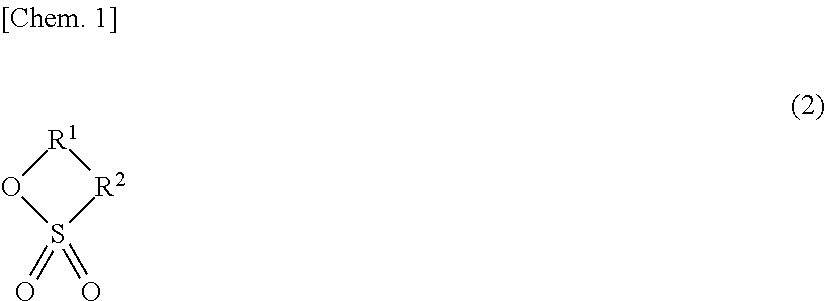Nonaqueous electrolytic solution and nonaqueous-electrolyte secondary battery
a secondary battery and electrolytic solution technology, applied in the field of nonaqueous electrolytic solution and nonaqueouselectrolyte secondary batteries, can solve the problems of non-uniformity in reliability and safety, uneven discharge characteristics among individual cells, and the capacity of lithium secondary batteries to be deteriorated and increased in internal impedance, so as to improve the initial charge capacity, input/output characteristics, input/output characteristics and impedance characteristics, the effect of improving the initial
- Summary
- Abstract
- Description
- Claims
- Application Information
AI Technical Summary
Benefits of technology
Problems solved by technology
Method used
Image
Examples
example 1
Production of Negative Electrode
[0694]To 98 parts by mass of artificial-graphite powder KS-44 (trade name; manufactured by Timcal) were added 100 parts by mass of an aqueous dispersion of sodium carboxymethyl cellulose (concentration of sodium carboxymethyl cellulose, 1% by mass) as a thickener and 2 parts by mass of an aqueous dispersion of a styrene / butadiene rubber (concentration of styrene / butadiene rubber, 50% by mass) as a binder. The ingredients were mixed together by means of a disperser to obtain a slurry. The slurry obtained was applied to one surface of a copper foil having a thickness of 10 μm and dried. This coated foil was pressed by rolling with a pressing machine, and a piece of a shape having an active-material layer size with a width of 30 mm and a length of 40 mm and having an uncoated area with a width of 5 mm and a length of 9 mm was cut out of the rolled sheet. Thus, a negative electrode was obtained.
[Production of Positive Electrode]
[0695]Ninety percents by ma...
example 2
[0700]In a dry argon atmosphere, 99.5 parts by mass of a mixture of ethylene carbonate (EC), dimethyl carbonate (DMC), and ethyl methyl carbonate (EMC) (volume ratio, 30:30:40) was mixed with 0.5 parts by mass of vinylene carbonate (VC). Subsequently, sufficiently dried LiFSO3 and LiPF6 were dissolved therein so as to result in proportions thereof of 0.1 mol / L and 0.9 mol / L, respectively. Thus, an electrolytic solution was obtained. A sheet-form lithium secondary battery was produced and evaluated in the same manners as in Example 1. The battery design is shown in Table 1, and the results of the evaluation are shown in Table 2.
example 3
[0701]A sheet-form lithium secondary battery was produced and evaluated in the same manners as in Example 1, except that an electrolytic solution was obtained in a dry argon atmosphere by mixing 99.5 parts by mass of a mixture of ethylene carbonate (EC), dimethyl carbonate (DMC), and ethyl methyl carbonate (EMC) (volume ratio, 30:30:40) with 0.5 parts by mass of vinylene carbonate (VC) and then dissolving sufficiently dried LiFSO3 and LiPF6 therein so as to result in proportions thereof of 0.3 mol / L and 0.7 mol / L, respectively. The battery design is shown in Table 1, and the results of the evaluation are shown in Table 2.
PUM
| Property | Measurement | Unit |
|---|---|---|
| temperature | aaaaa | aaaaa |
| valence | aaaaa | aaaaa |
| mass | aaaaa | aaaaa |
Abstract
Description
Claims
Application Information
 Login to View More
Login to View More - R&D
- Intellectual Property
- Life Sciences
- Materials
- Tech Scout
- Unparalleled Data Quality
- Higher Quality Content
- 60% Fewer Hallucinations
Browse by: Latest US Patents, China's latest patents, Technical Efficacy Thesaurus, Application Domain, Technology Topic, Popular Technical Reports.
© 2025 PatSnap. All rights reserved.Legal|Privacy policy|Modern Slavery Act Transparency Statement|Sitemap|About US| Contact US: help@patsnap.com


